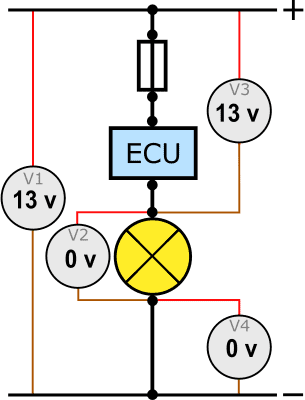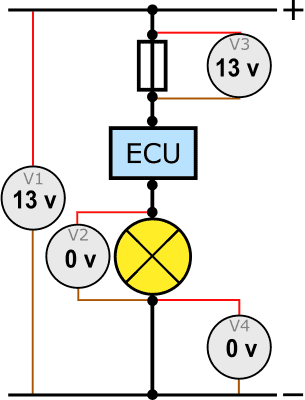Subjects:
- Measuring voltage
- Measuring current
- Measuring resistance
- V4 measurement
Measuring voltage:
With a multimeter we can measure the voltage (volts) across electrical components such as the battery, wiring, switch and lamp. We call it a "voltmeter". We put the multimeter in parallel across the circuit and set it as follows:
- We set the rotary knob to the V of volts (voltage);
- In this case we choose direct voltage (DC);
- Red test lead in the V terminal;
- Black test lead in the COM terminal.
The red measuring wire is the plus wire and the black one is the negative wire. At the end of the test leads are test probes. We hold the red test pin against the plus terminal of the battery and the black one against the minus. In this way we measure the voltage difference in the battery. This voltage is read from the display and is 1,5 volts.
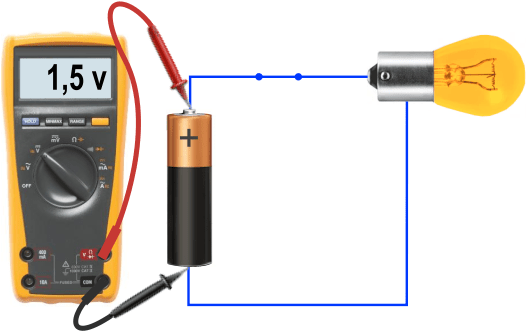
The battery voltage of 1,5 volts is routed through the positive wire to the positive terminal of the lamp when the switch is closed. With the multimeter we measure the voltage difference across the lamp: the bottom point is the plus and the housing is the mass. We hold the measuring pins against the plus and ground to measure the voltage difference across the lamp.
The moment the switch is opened, the circuit is broken. No current flows through the circuit, causing the lamp to turn off. The multimeter indicates 0 volts with this difference measurement. The switch is located on the plus side of the lamp, so that the lamp is voltage-free. In a section below, we will discuss plus and ground switched lamps and the associated difference measurements.
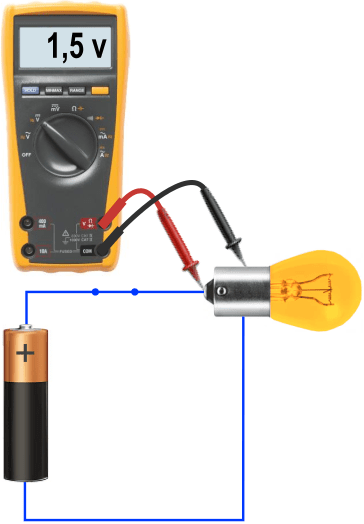
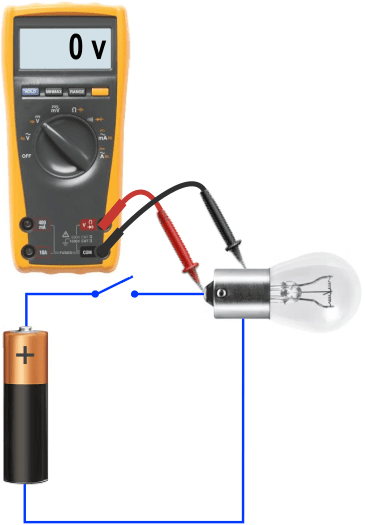
Measuring current:
The multimeter allows us to determine how much current is flowing through a circuit. Importantly, the multimeter must be connected in series. The current flows through the multimeter. We call it an “Ampmeter”. We set it up like this:
- We set the rotary knob to the A position of Ampere;
- With this type of multimeter, each time the A position is selected, the yellow button must be pressed to switch from AC to DC;
- The red test lead in the 10A socket;
- The black test lead into the COM terminal.
To put the multimeter in series, the power circuit must be interrupted somewhere. We can do this by removing the fuse or opening the switch. Where the circuit is broken, connect the measuring pins. The two images below show the current measurement with the switch open. It is measured in Ampere and in milliAmpère. More information about this follows below the images.
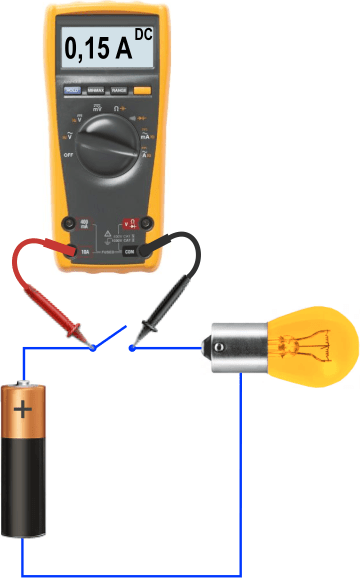
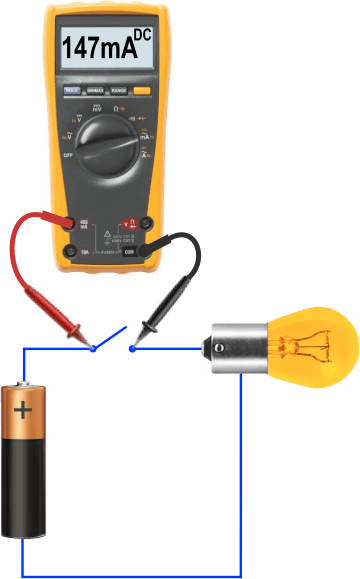
As we can see in the pictures, the current can be measured in two modes.
- The first measurement is in Ampere mode. In this mode, currents of up to 10 Ampere can be measured;
- The second reading is in milliAmps mode. In this mode, currents of up to 400 milliAmps can be measured. This is equal to 0,4 A.
If you are not yet able to estimate how much current flows through a circuit, it is wise to measure in the 10A position first. If the current is less than 0,4 A, you can decide to insert the measuring pin into the mA connection and set the rotary knob to mA. Don't forget to press the yellow button to switch from AC to DC. The measured value corresponds, but is more accurate in the mA mode
- 0,15 A is equal to 150 mA;
- 147 mA is therefore 0,147 A (so this position is more accurate).
Errors are sometimes made when measuring current. The most common errors are shown in the following two images.
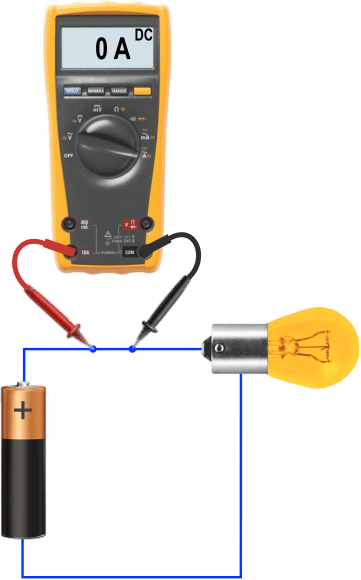
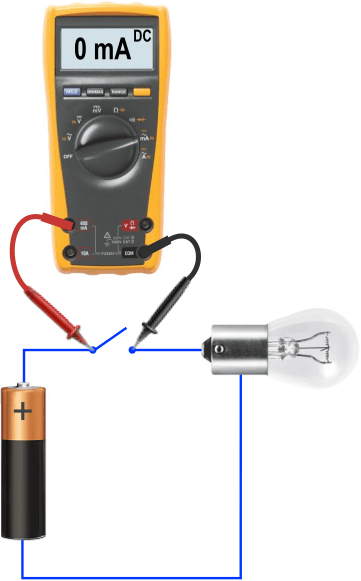
The moment we perform a measurement in which the consumer functions properly, in this case the lighted lamp, but the multimeter indicates 0 A, then the meter is still in AC, or the circuit has not been interrupted. The current follows the path of least resistance, and that is through the closed switch. In fact, the multimeter is now parallel across the circuit. This will not cause anything to malfunction. As soon as the switch is opened, the correct value appears in the display.
If the current exceeds the fuse rating, the fuse will blow to protect the electronics in the multimeter. In the mA mode, that is 400 mA. This is found when the meter is connected correctly, but the consumer remains off and the meter indicates 0 mA or 0 A. In this case, we can choose to carry out the measurement in A, as this position is protected up to 10 A and there is less chance that the fuse will blow or go.
Measuring resistance:
The third measurement we perform with the multimeter is the resistance measurement. We can measure electrical components for internal short circuits or interruptions. The images below show two measurements where the resistance of the lamp is determined. The multimeter now functions as an “ohmmeter” and is set as follows:
- The rotary selector is set to the Ω (ohm) position for resistance measurement;
- The red test lead is plugged into the Ω terminal, which is also the same terminal we use for the volt measurement;
- The black test lead is plugged back into the COM terminal.
The resistance of the lamp is 1,85 ohms. This indicates that the lamp is OK. Note: When the lamp is lit, the resistance changes with the temperature. We cannot measure the resistance while it is burning, but immediately after switching off the measured value will be a lot lower.
A lamp ages as it burns for many hours. The tungsten wire becomes thinner and evaporates against the inside of the glass. We can see this because the lamp gets dark. A dark-colored lamp will fail in a short period of time. That happened in the second measurement: the tungsten wire is broken and the lamp no longer works. The circuit is thus interrupted. Because the connection is broken, the resistance has become “infinitely” high. In that case, the multimeter will indicate OL. Some multimeters will then show “1.”
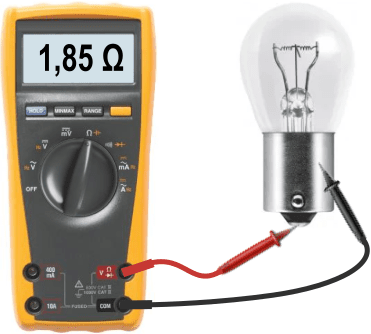
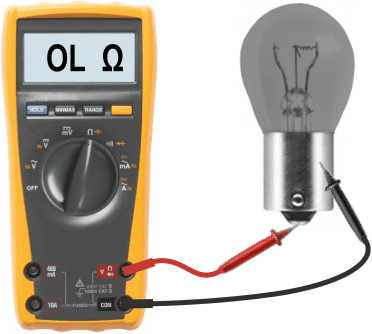
With the ohmmeter we can make the following measurements:
- the internal resistance of electrical and non-electrical components;
- locating breaks in an electrical circuit, such as in printed circuit boards or in wiring;
- locating electrical connections by means of the beep mode;
- finding a ground connection;
- Check that the test leads are OK.
The last measurement is crucial in making a diagnosis. The moment a test lead is in bad condition, it affects any voltage or current measurement with the multimeter or oscilloscope (the latter can only measure voltage).
The moment a test lead has been jammed once, or has been kinked a lot due to intensive use and it has been pulled, the connection can be lost if it is held at a certain angle. This can be checked simply by holding the ends of the measuring pins together: the resistance is then approximately 0,1 ohms. Is the resistance many times higher, or OL? Then the measuring wires are no longer usable.
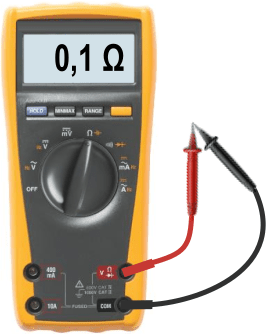
Another example of a resistance measurement is the measurement of the glow plug that we find in a diesel engine.
- A good glow plug has a resistance of about 6 ohms.
- If the glow plug is interrupted, the resistance is infinitely high.
- In case of internal closure (the coil and housing make internal contact), we measure (theoretically) a resistance of 0 and actually a resistance of 0,1 Ω due to the “always present” resistance in the test leads, as in the previous paragraph described when checking the test leads.
See the page about the glow plug for more information about the operation and measurement techniques.

V4 measurement:
This website describes the voltage levels, signal transfer and methods of measurement for many types of sensors, actuators, ECUs, and networks. These can be found on the pages themselves, such as from the temperature sensor, passive, active and intelligent sensors, relay en CAN bus. On these pages, measuring is specifically about that subject.
In most cases, when troubleshooting, we use the voltmeter and sometimes the clamp meter. We hardly or never carry out the ampere and resistance measurement during a diagnosis:
- To measure the current, the circuit must be interrupted (not desirable), and the height of the current does not say enough about possible losses. The current is the same throughout the circuit. Also, the ammeter is limited to 10A. It can sometimes be desirable to use a clamp meter that is not limited to a certain current strength.
- Measuring the resistance is only advisable when determining a connection or interruption. In all other cases we measure an “no load” resistance and the resistance value is unreliable.
The above means that we almost always use the voltmeter in our diagnosis. For complex diagnoses we use an oscilloscope, which is also a (graphic) voltmeter. With the voltmeter we measure voltage differences and losses in a loaded situation, i.e. when the consumer is active. This makes the reading the most useful.
It is useful to master the V4 measurement to give guidance on the measurements with the voltmeter. By means of four volt measurements, one can “approximately” find the cause of a poorly or non-functioning consumer. This section explains how to perform the V4 measurement, which measurement values you can expect and know when there is a malfunction.
With the V4 measurement, we use one voltmeter and perform a difference measurement at four specific points. We call these four measurements the V1, V2, V3 and V4.
Note: at a PWM / duty cycle controlled consumer it is not possible to perform this V4 measurement, the oscilloscope must be used for this!
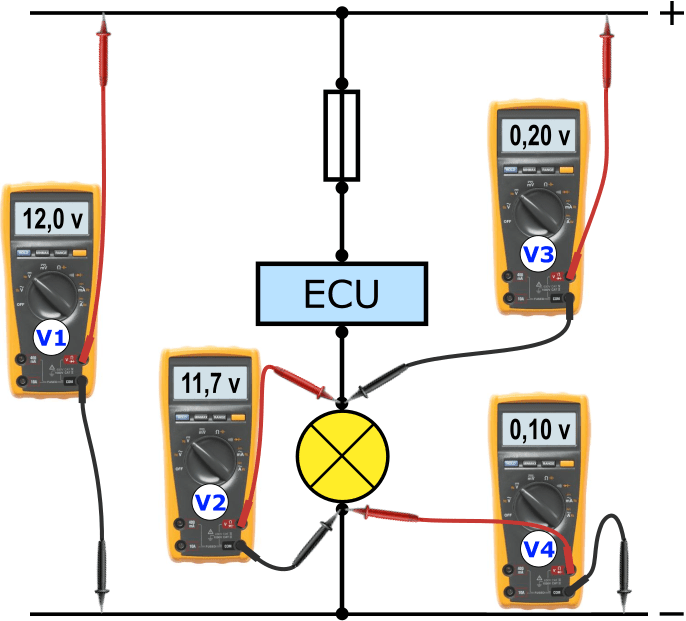
V1:
The V1 measurement is the first measurement we perform. We measure the battery voltage here. We compare all voltages that we measure below with this measured value. Before measuring is allowed, the consumer must be switched on. With heavy consumers, the battery voltage can drop by a few tenths of a volt, without there being a malfunction. We set the multimeter correctly (see the paragraph about measuring voltage) and we keep the measuring pins on the positive and ground pole of the battery.
Is it necessary to start the engine during the V4 measurement? Then the V1 measurement due to the alternator charging voltage will be higher. Then perform the measurement again.
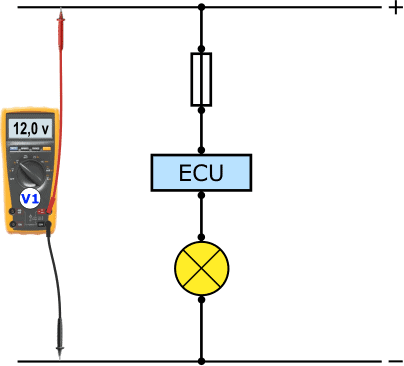
V2:
We then measure the voltage difference across the consumer. The consumer must of course be switched on. This is not so complicated with a lamp: we switch on the lamp with a switch. Sometimes switching on the consumer can be a little more difficult, for example the electric fuel pump in the tank. In this case, start an actuator test via a diagnostic tool, or let the engine idle.
- The voltage across the consumer must be about the same as the battery voltage, with a maximum difference of half a volt. If this is the case, there is no voltage drop in the positive or ground and the V4 measurement is completed;
- If the voltage at the V2 measurement is more than half a volt lower than the value V1, then there is a voltage drop. In that case we measure the voltages at the V3 and V4.
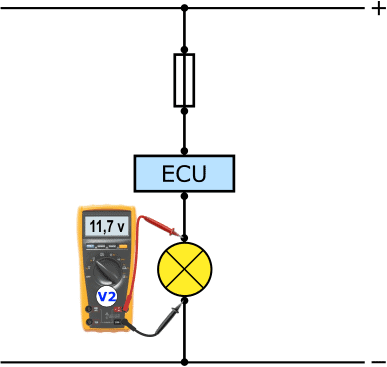
V3:
With this measurement we determine the voltage loss in the plus side, between the plus of the battery and the plus terminal of the lamp.
- The loss may not exceed 0,4 volts;
- Below 0,4 volts is fine;
- With more than 0,4 volts loss, there is a contact resistance in the plus side.
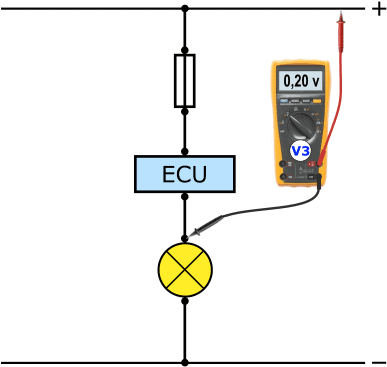
V4:
Finally, we perform the loss measurement between the mass of the lamp and the mass of the battery. The same applies here as for the V3 measurement: a maximum loss of 0,4 volts, otherwise there is a contact resistance.
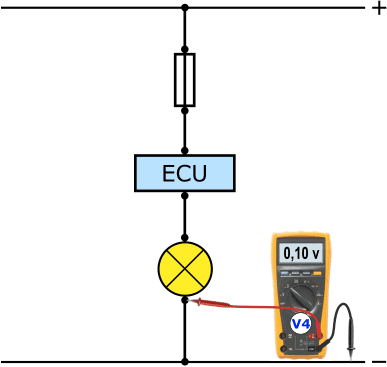
To check:
The battery voltage is distributed across the voltage circuit. All partial voltages (V2, V3 and V4) are equal to the battery voltage (V1). In the example above, this can be seen in the readings:
- V1 = 12,0 v
- V2 = 11,7 v
- V3 = 0,2 v
- V4 = 0,1V
With this we can fill in the following formula:
The moment the calculation deviates significantly, a measurement error has been made. One has to find out which value is not logical. For example, it is impossible for the lamp to burn at 12 volts when the battery voltage is 13 volts and there is a 12 volt voltage drop.
Below are five possible faults that can be detected with a V4 measurement. To save space and make it as clear as possible, the images of the "real" voltmeters have been replaced by a circle with the number in it.
Fault 1 - lamp is dimly lit:
The lamp burns weaker than other lamps in the vehicle. Logical, because it burns at only 7 volts instead of 13 volts. The result of V3 shows that there is 6 volts loss in the plus. In the part between the plus of the battery and the plus of the lamp there is a contact resistance where 6 volts is consumed. This voltage drop is at the expense of the voltage at which the consumer operates.
Possible causes:
- a damaged wire in front of the fuse, between the fuse and the ECU or between the ECU and the lamp;
- a bad connection of the fuse in the fuse holder;
- a bad wire connection or. plugs into one of the black dots in the diagram;
- a defect in the ECU.
To find out where the contact resistance is, we move the mind wire from the V3 meter to the bottom of the ECU. If we are still measuring 6 volts here, the voltage has not been lost in this wire and the cause is higher. However, if we measure 0 volts above the wire, this wire is damaged and must be replaced.
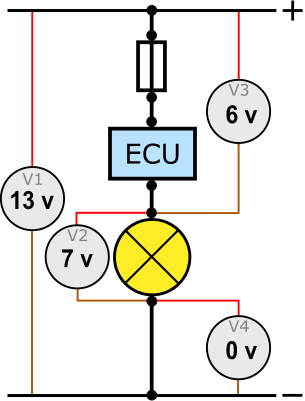
Fault 2 - lamp is dimly lit:
Once again we are dealing with a lamp that burns weaker than the rest. In the measured values we see that with measurement V4 there is a voltage drop of 6 volts. Also in this case 6 volts is needed to overcome the contact resistance in the ground.
Possible causes:
- a damaged wire between the lamp and a ground point;
- corrosion between the contact points of the cable eyelet and the ground point.
If the contact resistance is located in the wire, it is sufficient to install a new wire between the lamp and a ground point. If the wire is OK, it may help to unscrew and sand and clean the ground connection, then reassemble the wire and measure again.
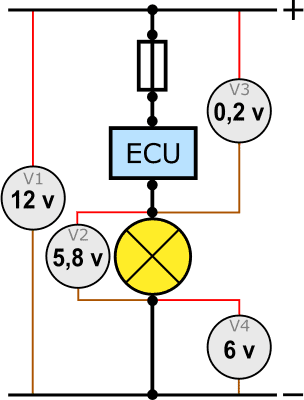
Fault 3 - lamp is dimly lit:
All lamps burn dimly. When performing the measurement, we see that the battery voltage is too low (V1). The loss measurements (V3 and V4) are OK. Charging (and perhaps testing) the battery is enough to solve the problem.
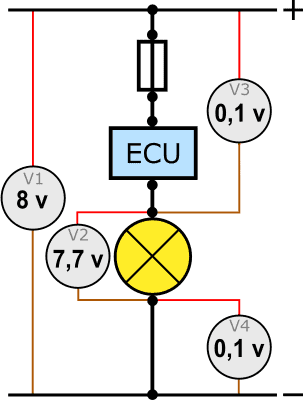
Fault 4 – lamp not lit:
The lamp is not lit. However, the voltage across the lamp is 13 volts and there is no loss.
Possible causes:
- lamp is defective: the power circuit has been interrupted due to an interrupted filament. The voltage of 13 volts and the ground still reach the lamp, so we do measure a "good" voltage difference at the V2;
- poor plug connection because the metal connectors have lost their clamping force. Frequent pulling and pressing of the plug on the lamp can create space between the metal plug and the connection of the lamp.
A defective lamp can often be assessed visually. The filament is visibly broken. If necessary, we measure the resistance of the lamp with the ohmmeter. An infinitely high resistance indicates an interruption.
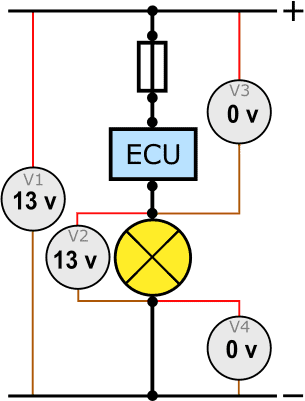
Fault 5 – lamp not lit:
We are again dealing with a lamp that does not burn. The voltage difference that we expect to measure at V2, we now measure at V3. This means that there is a good plus at the top of the fuse and a good ground at the bottom. Based on the measured value, the fuse now resembles a consumer using 13 volts, but this is incorrect.
The cause of this malfunction is a blown fuse. As with the previous failure, where the broken filament caused an interrupted power circuit, here the fuse interrupts the power circuit.
